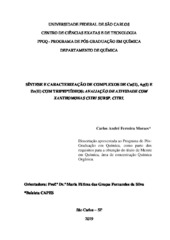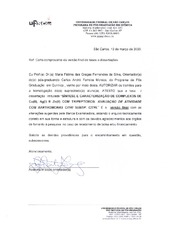| dc.contributor.author | Moraes, Carlos André Ferreira | |
| dc.date.accessioned | 2020-03-19T12:52:16Z | |
| dc.date.available | 2020-03-19T12:52:16Z | |
| dc.date.issued | 2019-09-06 | |
| dc.identifier.citation | MORAES, Carlos André Ferreira. Síntese e caracterização de complexos de Cu(II), Ag(I) E Zn(II) com tripeptídeos: avaliação de atividade com xanthomonas citri subsp. citri. 2019. Dissertação (Mestrado em Química) – Universidade Federal de São Carlos, São Carlos, 2019. Disponível em: https://repositorio.ufscar.br/handle/ufscar/12344. | * |
| dc.identifier.uri | https://repositorio.ufscar.br/handle/ufscar/12344 | |
| dc.description.abstract | SYNTHESIS AND CHARACTERIZATION OF Cu (II), Ag (I) AND Zn (II) COMPLEXES WITH TRIPEPTIDE LIGANDS: ACTIVITY EVALUATION IN XANTHOMONAS CITRI SUBSP. CITRI. In the search for new active substances against phytopathogens, were synthesized and characterized metal complexes with tripeptide L-Phenylalanine-Glycyl-Glycine (PGG), with general formula [Metal (PGG)]counterion, (PGG-1, PGG-2, PGG-3 and PGG-4), and the tripeptide Glycine-Glycyl-L-Histidine (GGH) of general formula [Metal (GGH)] (GGH-1, GGH-2, GGH-3 and GGH-4). These complexes were characterized by Elemental Analysis (C, H and N), Nuclear Magnetic Resonance (NMR) of 1H, 13C {1H}, one-dimensional and two-dimensional, high resolution mass spectrometry, absorption spectroscopy in ultraviolet-visible. The complexes PGG-1, PGG-2, PGG-3 and PGG-4, in water showed transitions n-π*, PGG-3 and PGG-4 exhibited d-d transitions. The GGH-1 and GGH-2 presented n-π* transitions, the complex GGH-3 and GGH-4 exhibited charge transfer bands (MLCT) and d-d transition. The differences found in the absorption spectrum bands in the infrared region (ligand and complex) were a smaller number of bands, inferring the rigidity caused by chelate formation. The copper (II) complexes were characterized by magnetic susceptibility, which are mononuclear. The complexes were tested on bacteria causing citrus canker, which had bacteriostatic activities, evaluated by technique serial microdilution, in which we obtained the Minimum Inhibitory Concentration (MIC), there was inhibited the growth of Xanthomonas citri subsp. citri, in lower concentration in some of the complexes (PGG-1, GGH-1 e PGG-3) compared to the salts used in the synthesis. The tripeptides used did not have bacteriostatic activity, related to the inhibition activity of bacterial growth to the synthesized complexes. | eng |
| dc.description.sponsorship | Coordenação de Aperfeiçoamento de Pessoal de Nível Superior (CAPES) | por |
| dc.language.iso | por | por |
| dc.publisher | Universidade Federal de São Carlos | por |
| dc.rights | Attribution-NoDerivs 3.0 Brazil | * |
| dc.rights.uri | http://creativecommons.org/licenses/by-nd/3.0/br/ | * |
| dc.subject | Cancro cítrico | por |
| dc.subject | Peptídeos | por |
| dc.subject | Complexos metálicos | por |
| dc.subject | Citrus canker | eng |
| dc.subject | Peptides | eng |
| dc.subject | Metal complexes | eng |
| dc.title | Síntese e caracterização de complexos de Cu(II), Ag(I) E Zn(II) com tripeptídeos: avaliação de atividade com xanthomonas citri subsp. citri | por |
| dc.title.alternative | Synthesis and characterization of Cu (II), Ag (I) AND Zn (II) complexes with tripeptide ligands: activity evaluation in xanthomonas citri subsp. citri | eng |
| dc.type | Dissertação | por |
| dc.contributor.advisor1 | Silva, Maria Fátima das Graças Fernandes da | |
| dc.contributor.advisor1Lattes | http://lattes.cnpq.br/0457632122660653 | por |
| dc.description.resumo | SÍNTESE E CARACTERIZAÇÃO DE COMPLEXOS DE COBRE (II), PRATA (I) E ZINCO (II) COM LIGANTES TRIPEPTÍDEOS: AVALIAÇÃO DE ATIVIDADE EM XANTHOMONAS CITRI SUBSP. CITRI. Na busca por novas substâncias ativas frente a fitopatógenos foram sintetizados e caracterizados complexos metálicos com o tripeptídeo L-Fenilalanina-Glicil-Glicina (PGG), com fórmula geral [Metal(PGG)]contra-íon, (PGG-1, PGG-2, PGG-3 e PGG-4), e com o tripeptídeo Glicina-Glicil-L-Histidina (GGH), de fórmula geral [Metal(GGH)], (GGH-1, GGH-2, GGH-3 e GGH-4). Estes complexos foram caracterizados por Análise Elementar (C, H e N), Ressonância Magnética Nuclear (RMN) de 1H, 13C{1H}, unidimensional e bidimensional, espectrometria de massas de alta resolução e espectroscopia de absorção na região do ultravioleta-visível. Os complexos PGG-1, PGG-2, PGG-3 e PGG-4, em água, apresentaram transições n-π*, o PGG-3 e PGG-4 mostraram transições d-d. Os complexos GGH-1 e GGH-2 apresentaram transições n-π*, os complexos GGH-3 e GGH-4 exibiram bandas de transferência de carga (TCML) e transição d-d. As diferenças encontradas nas bandas dos espectros de absorção na região do infravermelho (ligante e complexo) foram um número menor de bandas, inferido a rigidez causada pela formação dos quelatos. Os complexos de cobre(II) foram caracterizados por susceptibilidade magnética, os quais são mononucleares. Os complexos foram testados em bactérias causadoras do cancro cítrico, os quais tiveram atividades bacteriostática, avaliada pela técnica de microdiluição seriada, na qual obteve-se a Concentração Inibitória Mínima (CIM), houve a inibição do crescimento da Xanthomonas citri subsp. citri em concentração menor em alguns dos complexos (PGG-1, GGH-1 e PGG-3) comparados aos sais usados na síntese. Os tripeptídeos usados não possuem atividade bacteriostática, relacionou-se a atividade de inibição do crescimento das bactérias aos complexos sintetizados. | por |
| dc.publisher.initials | UFSCar | por |
| dc.publisher.program | Programa de Pós-Graduação em Química - PPGQ | por |
| dc.subject.cnpq | CIENCIAS EXATAS E DA TERRA::QUIMICA | por |
| dc.subject.cnpq | CIENCIAS EXATAS E DA TERRA::QUIMICA::QUIMICA ORGANICA::QUIMICA DOS PRODUTOS NATURAIS | por |
| dc.subject.cnpq | CIENCIAS EXATAS E DA TERRA::QUIMICA::QUIMICA INORGANICA | por |
| dc.subject.cnpq | CIENCIAS EXATAS E DA TERRA::QUIMICA::QUIMICA ORGANICA | por |
| dc.description.sponsorshipId | CAPES: código de financiamento - 001 | por |
| dc.publisher.address | Câmpus São Carlos | por |
| dc.contributor.authorlattes | http://lattes.cnpq.br/2574358034018138 | por |


